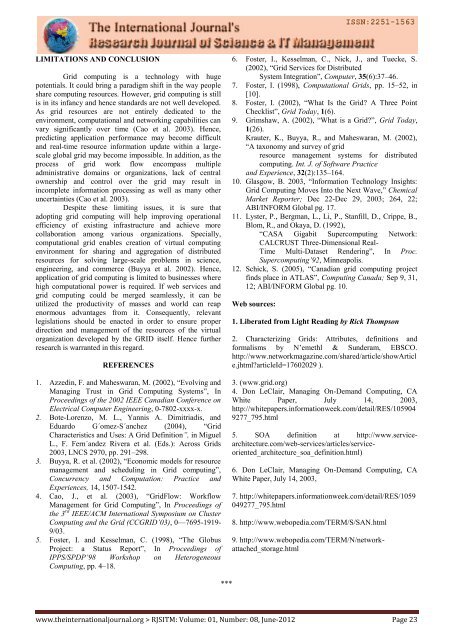Research Journal of Science & IT Management - RJSITM - The ...
Research Journal of Science & IT Management - RJSITM - The ...
Research Journal of Science & IT Management - RJSITM - The ...
Create successful ePaper yourself
Turn your PDF publications into a flip-book with our unique Google optimized e-Paper software.
LIM<strong>IT</strong>ATIONS AND CONCLUSION<br />
Grid computing is a technology with huge<br />
potentials. It could bring a paradigm shift in the way people<br />
share computing resources. However, grid computing is still<br />
is in its infancy and hence standards are not well developed.<br />
As grid resources are not entirely dedicated to the<br />
environment, computational and networking capabilities can<br />
vary significantly over time (Cao et al. 2003). Hence,<br />
predicting application performance may become difficult<br />
and real-time resource information update within a largescale<br />
global grid may become impossible. In addition, as the<br />
process <strong>of</strong> grid work flow encompass multiple<br />
administrative domains or organizations, lack <strong>of</strong> central<br />
ownership and control over the grid may result in<br />
incomplete information processing as well as many other<br />
uncertainties (Cao et al. 2003).<br />
Despite these limiting issues, it is sure that<br />
adopting grid computing will help improving operational<br />
efficiency <strong>of</strong> existing infrastructure and achieve more<br />
collaboration among various organizations. Specially,<br />
computational grid enables creation <strong>of</strong> virtual computing<br />
environment for sharing and aggregation <strong>of</strong> distributed<br />
resources for solving large-scale problems in science,<br />
engineering, and commerce (Buyya et al. 2002). Hence,<br />
application <strong>of</strong> grid computing is limited to businesses where<br />
high computational power is required. If web services and<br />
grid computing could be merged seamlessly, it can be<br />
utilized the productivity <strong>of</strong> masses and world can reap<br />
enormous advantages from it. Consequently, relevant<br />
legislations should be enacted in order to ensure proper<br />
direction and management <strong>of</strong> the resources <strong>of</strong> the virtual<br />
organization developed by the GRID itself. Hence further<br />
research is warranted in this regard.<br />
REFERENCES<br />
1. Azzedin, F. and Maheswaran, M. (2002), “Evolving and<br />
Managing Trust in Grid Computing Systems”, In<br />
Proceedings <strong>of</strong> the 2002 IEEE Canadian Conference on<br />
Electrical Computer Engineering, 0-7802-xxxx-x.<br />
2. Bote-Lorenzo, M. L., Yannis A. Dimitriadis, and<br />
Eduardo G´omez-S´anchez (2004), “Grid<br />
Characteristics and Uses: A Grid Definition”, in Miguel<br />
L., F. Fern´andez Rivera et al. (Eds.): Across Grids<br />
2003, LNCS 2970, pp. 291–298.<br />
3. Buyya, R. et al. (2002), “Economic models for resource<br />
management and scheduling in Grid computing”,<br />
Concurrency and Computation: Practice and<br />
Experiences, 14, 1507-1542.<br />
4. Cao, J., et al. (2003), “GridFlow: Workflow<br />
<strong>Management</strong> for Grid Computing”, In Proceedings <strong>of</strong><br />
the 3 rd IEEE/ACM International Symposium on Cluster<br />
Computing and the Grid (CCGRID’03), 0—7695-1919-<br />
9/03.<br />
5. Foster, I. and Kesselman, C. (1998), “<strong>The</strong> Globus<br />
Project: a Status Report”, In Proceedings <strong>of</strong><br />
IPPS/SPDP’98 Workshop on Heterogeneous<br />
Computing, pp. 4–18.<br />
6. Foster, I., Kesselman, C., Nick, J., and Tuecke, S.<br />
(2002), “Grid Services for Distributed<br />
System Integration”, Computer, 35(6):37–46.<br />
7. Foster, I. (1998), Computational Grids, pp. 15–52, in<br />
[10].<br />
8. Foster, I. (2002), “What Is the Grid? A Three Point<br />
Checklist”, Grid Today, 1(6).<br />
9. Grimshaw, A. (2002), “What is a Grid?”, Grid Today,<br />
1(26).<br />
Krauter, K., Buyya, R., and Maheswaran, M. (2002),<br />
“A taxonomy and survey <strong>of</strong> grid<br />
resource management systems for distributed<br />
computing. Int. J. <strong>of</strong> S<strong>of</strong>tware Practice<br />
and Experience, 32(2):135–164.<br />
10. Glasgow, B. 2003, “Information Technology Insights:<br />
Grid Computing Moves Into the Next Wave,” Chemical<br />
Market Reporter; Dec 22-Dec 29, 2003; 264, 22;<br />
ABI/INFORM Global pg. 17.<br />
11. Lyster, P., Bergman, L., Li, P., Stanfill, D., Crippe, B.,<br />
Blom, R., and Okaya, D. (1992),<br />
“CASA Gigabit Supercomputing Network:<br />
CALCRUST Three-Dimensional Real-<br />
Time Multi-Dataset Rendering”, In Proc.<br />
Supercomputing’92, Minneapolis.<br />
12. Schick, S. (2005), “Canadian grid computing project<br />
finds place in ATLAS”, Computing Canada; Sep 9, 31,<br />
12; ABI/INFORM Global pg. 10.<br />
Web sources:<br />
1. Liberated from Light Reading by Rick Thompson<br />
2. Characterizing Grids: Attributes, definitions and<br />
formalisms by N’emethl & Sunderam, EBSCO.<br />
http://www.networkmagazine.com/shared/article/showArticl<br />
e.jhtml?articleId=17602029 ).<br />
3. (www.grid.org)<br />
4. Don LeClair, Managing On-Demand Computing, CA<br />
White Paper, July 14, 2003,<br />
http://whitepapers.informationweek.com/detail/RES/105904<br />
9277_795.html<br />
5. SOA definition at http://www.servicearchitecture.com/web-services/articles/serviceoriented_architecture_soa_definition.html)<br />
6. Don LeClair, Managing On-Demand Computing, CA<br />
White Paper, July 14, 2003,<br />
7. http://whitepapers.informationweek.com/detail/RES/1059<br />
049277_795.html<br />
8. http://www.webopedia.com/TERM/S/SAN.html<br />
9. http://www.webopedia.com/TERM/N/networkattached_storage.html<br />
***<br />
www.theinternationaljournal.org > RJS<strong>IT</strong>M: Volume: 01, Number: 08, June-2012 Page 23
















